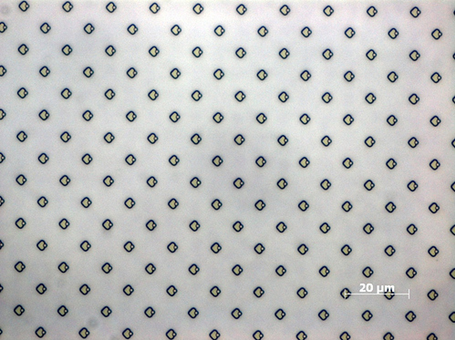Nanotechnology against fakes
Last year, at the height of the holiday season, US Customs and Immigration and Enforcement Enforcement (ICE) officers conducted a special operation Holiday Hoax, during which 327,000 units of counterfeit products were seized totaling $ 80 million. But counterfeit goods continue to be a serious problem for many countries.
Yes, fake technologies are developing, but at the same time counterfeiters continue to decompile these techniques, with the result that their products seem to be real.
But on the scene there are new methods of dealing with counterfeit from IBM, using technologies of a fundamentally new level - nano.
')

 At the beginning of the year, IBM scientists together with ETH Zurich University published an article in which they told how they managed with incredible precision to arrange gold nanorods ranging in size from 25 to 80 nanometers (for comparison, the pin head holds 1 million nanometers) on a flat surface using simple printing technology.
At the beginning of the year, IBM scientists together with ETH Zurich University published an article in which they told how they managed with incredible precision to arrange gold nanorods ranging in size from 25 to 80 nanometers (for comparison, the pin head holds 1 million nanometers) on a flat surface using simple printing technology.
For the demonstration, they created a copy of the famous German Ampelman , which turned out to be 2500 times smaller than the original.

“We used the surface tension of the water and the nanomatrix for the location of the nanorods, which can be printed on any surface using nano printing. We can create any image, such as a corporate logo or serial number, stopping fraudsters at the nanoscale level, ” said IBM scientist Heiko Wolf.
After fixing the particles, the image is entered into the base, and subsequently can be read by a special microscope.

Relatively recently, scientists from IBM have patented a similar technology of nanoimage. Another method involves spraying nanosized fluorescent points of polystyrene and glowing with different colors (red, green, and blue) over the document surface. Lying on the surface, they create a unique combination, which is theoretically impossible to fake today.
“The new method raises security to a new level, because the order of colors in which the elements are lined up is completely random. And even I can not make a copy of the image. We call this a physically unclonable function, abbreviated PUF (physically unclonable function). ”

Both technologies can be shared to counter the fakes of any high-quality goods, including diamonds, watches, famous paintings or even passports and other important documents.
According to Dr. Wolfe, these protection technologies will make unique things truly unique, and they will get their distribution within five years.
Read more: IBM Research , IBM flickr
Yes, fake technologies are developing, but at the same time counterfeiters continue to decompile these techniques, with the result that their products seem to be real.
But on the scene there are new methods of dealing with counterfeit from IBM, using technologies of a fundamentally new level - nano.
')

 At the beginning of the year, IBM scientists together with ETH Zurich University published an article in which they told how they managed with incredible precision to arrange gold nanorods ranging in size from 25 to 80 nanometers (for comparison, the pin head holds 1 million nanometers) on a flat surface using simple printing technology.
At the beginning of the year, IBM scientists together with ETH Zurich University published an article in which they told how they managed with incredible precision to arrange gold nanorods ranging in size from 25 to 80 nanometers (for comparison, the pin head holds 1 million nanometers) on a flat surface using simple printing technology.For the demonstration, they created a copy of the famous German Ampelman , which turned out to be 2500 times smaller than the original.

“We used the surface tension of the water and the nanomatrix for the location of the nanorods, which can be printed on any surface using nano printing. We can create any image, such as a corporate logo or serial number, stopping fraudsters at the nanoscale level, ” said IBM scientist Heiko Wolf.
After fixing the particles, the image is entered into the base, and subsequently can be read by a special microscope.

Relatively recently, scientists from IBM have patented a similar technology of nanoimage. Another method involves spraying nanosized fluorescent points of polystyrene and glowing with different colors (red, green, and blue) over the document surface. Lying on the surface, they create a unique combination, which is theoretically impossible to fake today.
“The new method raises security to a new level, because the order of colors in which the elements are lined up is completely random. And even I can not make a copy of the image. We call this a physically unclonable function, abbreviated PUF (physically unclonable function). ”

Both technologies can be shared to counter the fakes of any high-quality goods, including diamonds, watches, famous paintings or even passports and other important documents.
According to Dr. Wolfe, these protection technologies will make unique things truly unique, and they will get their distribution within five years.
Read more: IBM Research , IBM flickr
Nanorods Take Down Counterfeiters
Source: https://habr.com/ru/post/163631/
All Articles